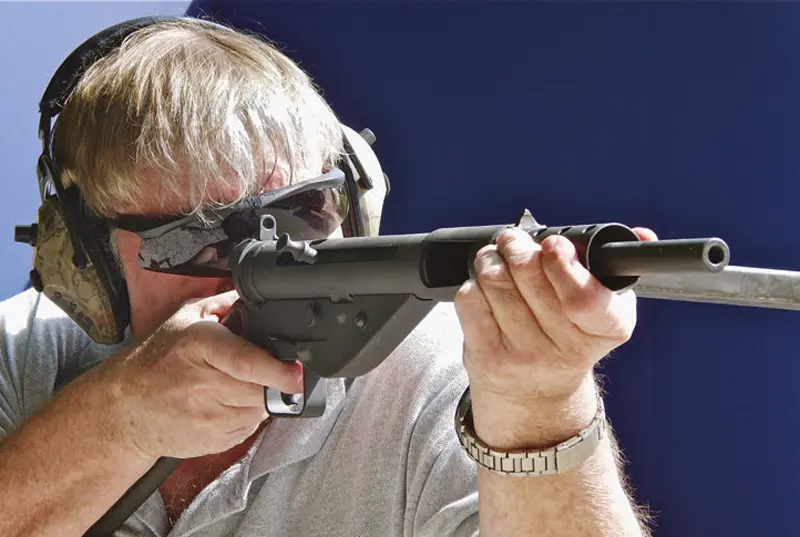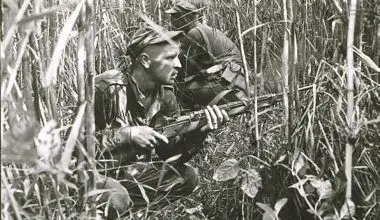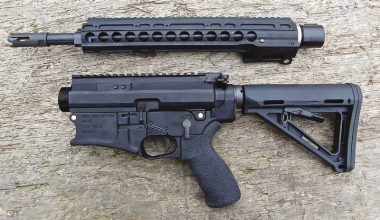After the evacuation of the British Expeditionary Force at Dunkirk in May/June 1940, Great Britain faced German invasion with few weapons to defend itself. Due to strict British gun laws, few civilians had arms other than double-barreled shotguns, which resulted in a call going out for Americans to donate arms to protect Great Britain.
The British also purchased just about anything available from U.S. firearms manufacturers and placed orders for Thompson SMGs. However, the Thompson was expensive and enough could not be produced to meet British needs, especially when the U.S. entered the War. As a result, the British decided to produce their own SMG domestically.


The first attempt was the Lanchester, which was basically a copy of the German MP28. It was adopted by the Royal Navy and used for decades after World War II. However, it was still expensive to produce. The gun that met the requirements of being inexpensive and quick to produce was a submachine gun designated the Sten. Principal designers were Major R.V. Shepherd and Mr. Harold J. Turpin, whose initials would be combined with the first two initials of the Royal Small Arms Factory Enfield to give the SMG its name—STEN.
Designed to use stamped components and a small amount of welding, the Sten only required minimal machining, and many of the design’s 47 parts could be subcontracted to small machine shops. A blowback design that fired from an open bolt that had a fixed firing pin, the Sten was produced in large numbers during WWII. Troops armed with the Sten (at least prior to the introduction of the Mk V) tended to like its handiness and firepower but disliked other aspects, especially its propensity to accidental or negligent discharges. Many troops termed it the “Stench Gun.”
Most criticisms arose from one of two factors. The magazine was adapted from the Lanchester/MP28 design, which used a double column that merged at the top of the magazine to a single column to feed. Debris or minor dents to the magazine could cause feed problems. The side feed magazine also offered troops a good gripping point for the support hand, but this could wear the magazine catch and change the feed angle, thus causing malfunctions.


The other major criticism was the Sten’s rudimentary safety. Consisting of a notch in the receiver into which the cocking handle could be rotated, the safety could easily be jarred off, causing the weapon to fire. Even if carried with the bolt closed on an empty chamber, a jar to the stock might cause the bolt to jump back and cause the Sten to fire.
Experienced users learned to use the hand as an additional safety, carrying the Sten with the hand wrapped around the receiver behind the bolt when carried bolt forward, or with the hand wrapped in front of the bolt when carried with the bolt cocked and/or in the safety position.
Other features of the basic Sten were a skeleton or T-stock, very basic sights, crossbolt selector for semi or full auto, and ventilated handguard. Estimates vary as to the total number of Stens produced, but it was somewhere around four million, plus or minus 100,000. The version produced in the largest number was the Mk II, while the Mk V is generally considered the best of the various types.
Suppressed versions—the Mk II (S) and Mk VI (S)—were produced for special operations use. “S” did not stand for suppressed or silenced but “special purpose.” Mk II (S) Stens were used by U.S. Special Forces in Vietnam. Mk VI (S) was actually the designation for a suppressed Mk V Sten.
The Mk II Sten had been developed from the Mk I to simplify production even more. Among other changes, the Mk I Sten’s flash hider was deleted, as were the vertical foregrip and wooden forearm and stock. As the Sten was deemed a good choice for airborne troops and for dropping to European Resistance groups, the Mk II was designed to allow the barrel and stock to be quickly removed and replaced so that it would fit into drop containers more readily or be tucked into paratroopers’ parachute harnesses. And to make the Mk II easier to stow for dropping or jumping, the magazine well could be rotated out of the horizontal position to beneath the receiver.
The Mk III Sten was designed for very simple production using stampings with holes pre-drilled. It used a fixed barrel and had a longer barrel shroud that extended almost to the end of the barrel. A substantial portion of the Mk III Stens went to the Home Guard, who were charged with countering German paratroopers or other invaders. The designation Mk IV was only used for prototype versions.

The final version of the Sten, the Mk V, is viewed by most who have used it as the finest of the Stens. By the time production began on the Mk V, the situation was not as dire as when the Mk I Sten went into production. As a result, the Mk V incorporated a wooden stock with pistol grip and, on earlier versions, a vertical wooden foregrip. It also used the same front sight as the British Enfield service rifle. The Mk V also took a bayonet.
For this column, I did some shooting with the Mk II Sten to refresh my memory. I’ve fired the Mk II, Mk II (S), and Mk V Sten at various times.
I found the Mk II about as difficult to shoot well as I remembered. Balance is not great due to the weight of the full magazine extending out to the left. I had to exert some torque to the right with my wrist to counter the weight of a full magazine. The front pistol grip on the Mk V makes it much easier to handle and fire. The rear peep and front triangle sights are rudimentary at best.
I also found that the skeleton stock tended to shift against my shoulder when fired in bursts. I was firing bursts at hanging plates at 25 to 35 yards and found it difficult to keep shots on target. But the more I shot the Sten, the more hits I got. Like most weapons, it takes practice, but to shoot it well, quite a bit of practice.
I wouldn’t choose the Sten over an MP5, AKSU or many other SMGs. On the other hand, if I were in the Home Guard along the coast of England in 1941 awaiting a possible German invasion, I certainly would have preferred it to a pitchfork or double-barreled shotgun. The Sten was designed to arm a lot of men very quickly and was chambered for the 9mm Parabellum cartridge, which members of the Home Guard, British paratroopers, and Resistance fighters could acquire from captured German supplies.
When Winston Churchill made his famous “We Shall Fight on the Beaches” speech in 1940, the Sten gun was not yet available. Once it was, there is little doubt it would have been there behind the beaches to fight Germans attempting to advance inland.





